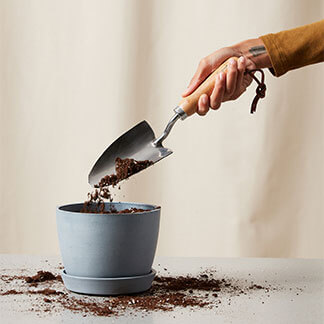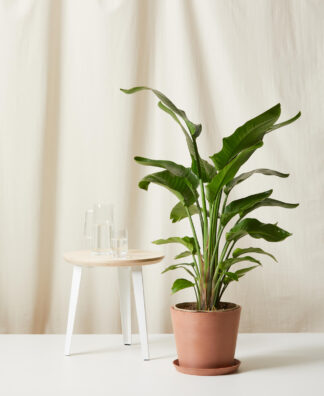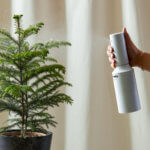How to care for your Fiddle Leaf Fig
Use these instructions to care for a Fiddle Leaf Fig. This guide will tell you how to water a Fiddle Leaf Fig; its light, temperature, humidity preferences and any additional care it might need to help it grow.
Fiddle Leaf Fig
Keep your fiddle leaf fig in bright indirect light. This plant will not tolerate low light and its leaves will eventually yellow and drop. Close to an eastern window or acclimated to the direct light from a southern window is ideal.
Water when 50-75% of the soil volume is dry. Always water thoroughly until it flows out of the drainage hole to encourage a healthy root system. Discard any excess water in the saucer.
The fiddle leaf fig does fine in average household humidity, but won’t mind an extra humidity boost.
Your fiddle leaf fig enjoys average room temperatures of 60-80°F. Avoid drafty areas or open vents.
For best results, feed your plant once during the spring and monthly throughout the summer. Over-fertilizing can cause the fiddle leaf fig to grow leggy and can even kill it. A little bit of food will go a long way to encourage growth and root health. No fertilizer is necessary during the winter when plant growth naturally slows.
Fiddle leaf figs are toxic to humans and pets if ingested.
When pruning your plant, watch out for the milky latex substance that leaks out where cuts have occurred—this is a mildly toxic irritant. If you get the sap on your hands or skin, wash with warm water and soap immediately.
Fiddle Leaf Fig Column
Your fiddle leaf fig will grow best with consistent, indirect bright light. Turn the plant every few months once it begins to lean towards the light.
Water when 50-75% of the soil becomes dry, then thoroughly drench until the water drains into the saucer. Empty the saucer if the water level is high so as not to drown the roots.
As a native to the tropics, fiddle leaf figs thrive in warm, wet conditions. Mist the leaves to increase humidity around your plant, especially in the drier winter months.
The fiddle leaf fig enjoys warmer temperatures, but it adapts easily to your home or office climate. However, it will not tolerate cold drafts so make sure you seal up drafty areas before situating your fig.
For best results, feed your plant once during the spring and monthly throughout the summer. Over-fertilizing can cause the fiddle leaf fig to grow leggy and can even kill it. A little bit of food will go a long way to encourage growth and root health. No fertilizer is necessary during the winter when plant growth naturally slows.
Fiddle leaf fig leaves are mildly toxic to humans and pets. Typically, ingestion will cause mouth and stomach irritation and possible vomiting.
Large leaves can collect dust. If you notice the leaves are dirty or dusty, wipe them with a damp cloth and gently dry to keep them clean and healthy. You can also add a teaspoon of dishwashing detergent to one gallon of water as a precaution against insects. Fiddle leaf figs do not like to be moved—if necessary to move your plant, be prepared for some leaf drop until it is acclimated again in approximately 2-3 weeks.
Ficus Little Fiddle
Your Little Fiddle Leaf Fig will grow best with consistent, indirect bright light. Turn the plant every few months once it begins to lean towards the light.
Water when the soil is 50-75% dried, then thoroughly drench until the water drains into the saucer. Empty the saucer if the water level is high so as not to drown the roots.
As a native to the tropics, Fiddle Leaf Figs thrive in warm, wet conditions. Mist the leaves to increase humidity around your plant, especially in the drier winter months.
The Fiddle Leaf Fig enjoys warmer temperatures, but it adapts easily to your home or office climate. However, it will not tolerate cold drafts so make sure you seal up drafty areas before situating your fig.
For best results, feed your plant once during the spring and monthly throughout the summer. Overfertilizing can cause the Fiddle Leaf Fig to grow leggy and can even kill it. A little bit of food will go a long way to encourage growth and root health. No fertilizer is necessary during the winter when plant growth naturally slows.
Fiddle Leaf Fig leaves are mildly toxic to humans and pets. Typically, ingestion will cause mouth and stomach irritation and possible vomiting.
Large leaves can collect dust. If you notice the leaves are dirty or dusty, wipe them with a damp cloth and gently dry to keep them clean and healthy. You can also add a teaspoon of dishwashing detergent to one gallon of water as a precaution against insects. Fiddle Leaf Figs do not like to be moved—if necessary to move your plant, be prepared for some leaf drop until it is acclimated again in approximately 2–3 weeks.
Ficus Lyrata Bonsai
Your Ficus Bonsai will grow best with consistent, bright, filtered light. Turn the plant every few months once it begins to lean towards the light. It will prefer an east-facing, sunny window as afternoon sun from the south or west-facing window will be too strong and may burn the leaves.
Water when the soil is 75% dried, then thoroughly drench until the water drains into the saucer. Empty the saucer if the water level is high so as not to drown the roots. If your plant does not get enough water, the leaves will become limp and floppy, eventually turning brown or yellow before falling off.
As a native to the tropics, Fiddle Leaf Figs thrive in warm, wet conditions. Mist the leaves to increase humidity around your plant, especially in the drier winter months.
The Fiddle Leaf Fig enjoys warmer temperatures, but it adapts easily to your home or office climate. However, it will not tolerate cold drafts so make sure you seal up drafty areas before situating your fig.
For best results, feed your plant once during the spring and monthly throughout the summer. Overfertilizing can cause the Fiddle Leaf Fig to grow leggy and can even kill it. A little bit of food will go a long way to encourage growth and root health. No fertilizer is necessary during the winter when plant growth naturally slows.
Fiddle Leaf Fig leaves are mildly toxic to humans and pets. Typically, ingestion will cause mouth and stomach irritation and possible vomiting.
As this plant is a bonsai, regular pruning is required to keep its compact shape. As the leaves grow, cut them back to keep growth small.
















